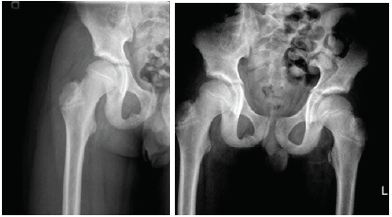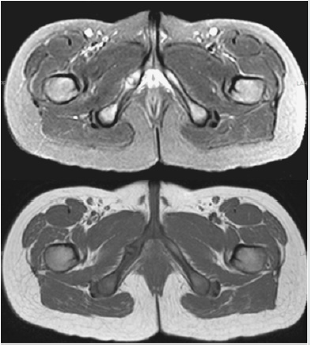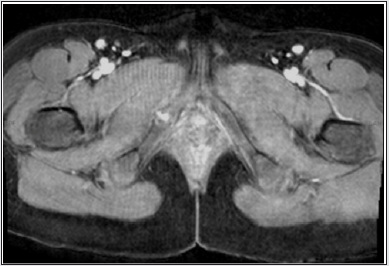
Lupine Publishers Group
Lupine Publishers
Menu
ISSN: 2638-6003
Case Report(ISSN: 2638-6003) 
The Painful Ischiopubic Synchondrosis: A Case Report Volume 2 - Issue 3
Carvalho Ruben1* and Huang Mingqian2
- 1Department of Imaging service, Hospital of Santarem, Portugal
- 2Department of Radiology, Stony Brook, USA
Received: December 17, 2018 Published: December 21, 2018
Corresponding author: Carvalho Ruben, Department of Imaging service, Hospital of Santarem, Santarem, Portugal
DOI: 10.32474/OSMOAJ.2018.02.000140
Abstract
Van Neck-Odelberg disease is considered a benign skeletal developmental abnormality seen in children, comprising hyperostosis of the ischiopubic synchondrosis (IPS). During skeletal development, typically there is unilateral and asymmetric enlargement of the IPS of no pathological relevance. Nevertheless, in spite of being considered a physiological phenomenon, some children can be clinically symptomatic and experience unspecific groin pain and limping. Importantly, the diagnosis of IPS opsteochondritis cannot be established by radiographic findings solely and needs to be supported by the appropriate clinical scenario and by the exclusion of other causes such as neoplasia, stress fracture, osteomyelitis, and post-traumatic osteolysis. The role of imaging is essentially to exclude these causes.
Keywords:Musculoskeletal; Radiography; MRI; Osteochondrosis
Case Presentation
Clinical History
A 10-year-old boy presented with right groin pain and a limping leg aggravated after football practice.
Imaging Findings
In the hip radiographs (Figure 1), there was no evidence of an acute fracture, but a sharp asymmetric shadow was seen at the right ischiopubic synchondrosis with no associated periosteal reaction or soft tissue thickening.The triradiate cartilage and hip joint spaces were symmetric and unremarkable. The MRI (Magnetic Resonance Imaging) depicted a prominent asymmetric synchondrosis of the right inferior pubic ramus with mild associated edema (Figure 2) and minimal enhancement (Figure 3). There was no evidence of fracture or stress response. These imaging findings in the current clinical setting lead to a diagnosis of VND.
Figure 1: AP radiographs of the Hip: A sharphly demarcated assymetric shadow was seen at the right ischiopubic synchondrosis and extending into the obturator foramen, with no associated periosteal reaction or soft tissue thickening.

Figure 2: Bony pelvis MRI (Upper image T2FS ; Bottom image T1)- Assymetric prominent right isquiopubic synchondrosis with hyperintense signal and mild surrounding sof tissue edema on fluid sensitive sequence and hypointense signal on T1.

Figure 3: Bony pelvis MRI, Axial T1 post intravenous paramagnetic contrast administration: There is mild enhancement of the assymetric prominent right isquiopubic synchondrosis.

Discussion
VND is a benign skeletal developmental abnormality seen in children, comprising hyperostosis of the ischiopubic synchondrosis (IPS), and it was first described by Odelberg and Van Neck in radiographs of prepubescents [1,2]. The IPS consists of cartilaginous tissue lying between the two ossification centers of the ischiopubic region: the superomedial pubic center and posterolateral ischial center [3,4]. IPS acts as a temporary joint between the ischium and pubis, and its ossification begins early in childhood completes before puberty [3,4]. In the latter stage of this process there is unilateral asymmetric enlargement, of no pathological relevance [4,5]. IPS are commonly asymmetric in asymptomatic children, with 50% of asymptomatic children of ages between 4-5 years old exhibiting asymmetric closure of this site, which can persist for several years [6].
In spite of being considered a physiological phenomenon which some authors relate to mechanical stress conditioned by iliopsoas, adductors, and gemellus, leading to delayed union of the cartilage and ossification centers [4,5,7], some children can be clinically symptomatic and experience groin pain and limping, regarded by some authors as a consequence of the inflammatory reaction conditioned by the constant movement of the IPS [4,7].
Clinical Perspective
Patients may complain of an unspecific groin or buttock pain [8]. The differential diagnosis includes stress fractures, osteomyelitis, post-traumatic osteolysis or neoplasia [3,7,8]. Ostechondritis of the IPS is often a diagnosis of exclusion and laboratory test are generally unremarkable [7].
Imaging Perspective
An enlarged and assymetric IPS is generally consided as an anatomical developmental variant [6], furthermore, the diagnosis of VND cannot be established by radiographic findings solely and needs to be supported by the appropriate clinical scenario and the primary role of imaging is to exclude other causes [3,5]. The typical finding of VNP in radiographs is of an asymmetric sharply circumscribed shadow located in the ischiopubic region extending towards the obturator foramen without periosteal reaction or soft tissue thickening [1,2,8]. CT (computed tomography) and MRI usually show asymmetric enlargement of the IPS, furthermore, on MRI there is hyperintense signal on T2 with fat saturation and STIR sequences and hypointense signal on T1, with fibrous bridging and fusiform swelling of the IPS [3,5,8]. There can be mild associated soft tissue edema and minimal post contrast enhancement [5]. Radiologically it can extend for several months to a year period, although when the ossification completes, no signs will subsist [7].
Take Home Message, Teaching Points
a) The Diagnosis of VND is clinically challenging and other entities such as stress fracture, osteomyelitis, post-traumatic osteolysis, should be excluded.
b) Clinical symptoms are a must condition to identify a delayed unilateral ischiopubic synchondrosis as VND.
c) Imaging value is in excluding other entities.
References
- Odelberg A (1923) Some cases of destruction in the ischium of doubtful etiology. Acta Chir Scand (56): 273-284.
- M VN (1924) Osteochondrite du pubis. Arch Fr Chir (27): 238-241.
- Chaudhari AP, Shah G, Patil SS, Ghodke AB (2017) Van Neck-Odelberg Disease: A Rare Case Report. J Orthop Case Reports 1(7): 24-27.
- L H (1965) Closure rhythm and closure disorders of synchondrosis ischiopubica and their dependence on the pathology of the hip joint (contribution to the clinical aspects of the growing pelvis). Z Orthop Ihre Grenzgeb 100(1): 38-91.
- Herneth AM, Trattnig S, Bader TR, Ba SA, Ponhold W, et al. (2000) MR imaging of the ischiopubic synchondrosis. Magn Reson Imaging 18(5): 519-524.
- Caffey J RS (1956) The ischiopubic synchondrosis in healthy children: Some normal roentgenologic findings. Am J Roentgenol Radium Ther Nucl Med 76(3): 488-494.
- Wait A, Gaskill T, Sarwar Z, Busch M (2011) Van neck disease: Osteochondrosis of the ischiopubic synchondrosis. J Pediatr Orthop 31(5): 520-524.
- Macarini L, Lallo T, Milillo P, Muscarella S, Vinci R, et al. (2011) Case report: Multimodality imaging of Van Neck-Odelberg disease. Indian J Radiol Imaging 21(2): 107-110.

Top Editors
-

Mark E Smith
Bio chemistry
University of Texas Medical Branch, USA -

Lawrence A Presley
Department of Criminal Justice
Liberty University, USA -

Thomas W Miller
Department of Psychiatry
University of Kentucky, USA -

Gjumrakch Aliev
Department of Medicine
Gally International Biomedical Research & Consulting LLC, USA -

Christopher Bryant
Department of Urbanisation and Agricultural
Montreal university, USA -

Robert William Frare
Oral & Maxillofacial Pathology
New York University, USA -

Rudolph Modesto Navari
Gastroenterology and Hepatology
University of Alabama, UK -

Andrew Hague
Department of Medicine
Universities of Bradford, UK -

George Gregory Buttigieg
Maltese College of Obstetrics and Gynaecology, Europe -

Chen-Hsiung Yeh
Oncology
Circulogene Theranostics, England -
.png)
Emilio Bucio-Carrillo
Radiation Chemistry
National University of Mexico, USA -
.jpg)
Casey J Grenier
Analytical Chemistry
Wentworth Institute of Technology, USA -
Hany Atalah
Minimally Invasive Surgery
Mercer University school of Medicine, USA -

Abu-Hussein Muhamad
Pediatric Dentistry
University of Athens , Greece

The annual scholar awards from Lupine Publishers honor a selected number Read More...










